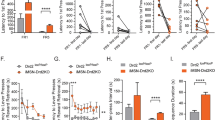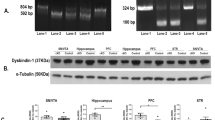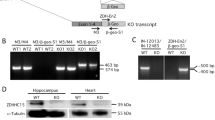Abstract
Palmitoyl-protein thioesterase 1 (PPT1) is a lysosomal depalmitoylation enzyme that mediates protein posttranslational modifications. Loss-of-function mutation of PPT1 causes a failure of the lysosomal degradation of palmitoylated proteins and results in a congenital disease characterized by progressive neuronal degeneration referred to as infantile neuronal ceroid lipofuscinosis (INCL). A mouse knock-in model of PPT1 (PPT1-KI) was established by introducing the R151X mutation into exon 5 of the PPT1 gene, which exhibited INCL-like pathological lesions. We previously reported that hippocampal γ oscillations were impaired in PPT1 mice. Hippocampal γ oscillations can be enhanced by selective activation of the dopamine D4 receptor (DR4), a dopamine D2-like receptor. In this study, we investigated the changes in DR expression and the effects of dopamine and various DR agonists on neural network activity, cognition and motor function in PPT1KI mice. Cognition and motor defects were evaluated via Y-maze, novel object recognition and rotarod tests. Extracellular field potentials were elicited in hippocampal slices, and neuronal network oscillations in the gamma frequency band (γ oscillations) were induced by perfusion with kainic acid (200 nM). PPT1KI mice displayed progressive impairments in γ oscillations and hippocampus-related memory, as well as abnormal expression profiles of dopamine receptors with preserved expression of DR1 and 3, increased membrane expression of DR4 and decreased DR2 levels. The immunocytochemistry analysis revealed the colocalization of PPT1 with DR4 or DR2 in the soma and large dendrites of both WT and PPT1KI mice. Immunoprecipitation confirmed the interaction between PPT1 and DR4 or DR2. The impaired γ oscillations and cognitive functions were largely restored by the application of exogenous dopamine, the selective DR2 agonist quinpirole or the DR4 agonist A412997. Furthermore, the administration of A412997 (0.5 mg/kg, i.p.) significantly upregulated the activity of CaMKII in the hippocampus of 5-month-old PPT1KI mice. Collectively, these results suggest that the activation of D2-like dopamine receptors improves cognition and network activity in PPT1KI mice and that specific DR subunits may be potential targets for the intervention of neurodegenerative disorders, such as INCL.
This is a preview of subscription content, access via your institution
Access options
Subscribe to this journal
Receive 12 print issues and online access
269,00 € per year
only 22,42 € per issue
Buy this article
- Purchase on SpringerLink
- Instant access to full article PDF
Prices may be subject to local taxes which are calculated during checkout









Similar content being viewed by others
References
Lin DTS, Davis NG, Conibear E. Targeting the Ras palmitoylation/depalmitoylation cycle in cancer. Biochem Soc Trans. 2017;45:913–21.
Salaun C, Greaves J, Chamberlain LH. The intracellular dynamic of protein palmitoylation. J Cell Biol. 2010;191:1229–38.
Kong E, Peng S, Chandra G, Sarkar C, Zhang Z, Bagh MB, et al. Dynamic palmitoylation links cytosol-membrane shuttling of acyl-protein thioesterase-1 and acyl-protein thioesterase-2 with that of proto-oncogene H-ras product and growth-associated protein-43. J Biol Chem. 2013;288:9112–25.
Kang R, Wan J, Arstikaitis P, Takahashi H, Huang K, Bailey AO, et al. Neural palmitoyl-proteomics reveals dynamic synaptic palmitoylation. Nature. 2008;456:904–9.
Ahtiainen L, Van Diggelen OP, Jalanko A, Kopra O. Palmitoyl protein thioesterase 1 is targeted to the axons in neurons. J Comp Neurol. 2003;455:368–77.
Lehtovirta M, Kyttala A, Eskelinen EL, Hess M, Heinonen O, Jalanko A. Palmitoyl protein thioesterase (PPT) localizes into synaptosomes and synaptic vesicles in neurons: implications for infantile neuronal ceroid lipofuscinosis (INCL). Hum Mol Genet. 2001;10:69–75.
Segal-Salto M, Hansson K, Sapir T, Kaplan A, Levy T, Schweizer M, et al. Proteomics insights into infantile neuronal ceroid lipofuscinosis (CLN1) point to the involvement of cilia pathology in the disease. Hum Mol Genet. 2017;26:1678.
Vergoten G, Bailly C Binding of hydroxychloroquine and chloroquine dimers to palmitoyl-protein thioesterase 1 (PPT1) and its glycosylated forms: a computational approach. J Biomol Struct Dyn. 2022;40:8197–8205.
Augustine EF, Adams HR, de Los Reyes E, Drago K, Frazier M, Guelbert N, et al. Management of CLN1 disease: international clinical consensus. Pediatr Neurol. 2021;120:38–51.
Balouch B, Nagorsky H, Pham T, LaGraff JT, Chu-LaGraff Q. Human INCL fibroblasts display abnormal mitochondrial and lysosomal networks and heightened susceptibility to ROS-induced cell death. PLoS One. 2021;16:e0239689.
Kravljanac R, Sims K. A case of juvenile CLN1- challenge in diagnosis and epilepsy treatment. Neurocase. 2021;27:165–8.
Geraets RD, Koh S, Hastings ML, Kielian T, Pearce DA, Weimer JM. Moving towards effective therapeutic strategies for Neuronal Ceroid Lipofuscinosis. Orphanet J Rare Dis. 2016;11:40.
Kim SJ, Zhang Z, Sarkar C, Tsai PC, Lee YC, Dye L, et al. Palmitoyl protein thioesterase-1 deficiency impairs synaptic vesicle recycling at nerve terminals, contributing to neuropathology in humans and mice. J Clin Invest. 2008;118:3075–86.
Kim SJ, Zhang Z, Lee YC, Mukherjee AB. Palmitoyl-protein thioesterase-1 deficiency leads to the activation of caspase-9 and contributes to rapid neurodegeneration in INCL. Hum Mol Genet. 2006;15:1580–6.
Wei H, Kim SJ, Zhang Z, Tsai PC, Wisniewski KE, Mukherjee AB. ER and oxidative stresses are common mediators of apoptosis in both neurodegenerative and non-neurodegenerative lysosomal storage disorders and are alleviated by chemical chaperones. Hum Mol Genet. 2008;17:469–77.
Miller JN, Kovacs AD, Pearce DA. The novel Cln1(R151X) mouse model of infantile neuronal ceroid lipofuscinosis (INCL) for testing nonsense suppression therapy. Hum Mol Genet. 2015;24:185–96.
Bouchelion A, Zhang Z, Li Y, Qian H, Mukherjee AB. Mice homozygous for c.451C>T mutation in Cln1 gene recapitulate INCL phenotype. Ann Clin Transl Neurol. 2014;1:1006–23.
Stoiljkovic M, Kelley C, Nagy D, Hajos M. Modulation of hippocampal neuronal network oscillations by alpha7 nACh receptors. Biochem Pharmacol. 2015;97:445–53.
Zhang X, Wang M, Feng B, Zhang Q, Tong J, Wang M, et al. Seizures in PPT1 knock-in mice are associated with inflammatory activation of microglia. Int J Mol Sci. 2022;23:5586.
Andersson RH, Johnston A, Herman PA, Winzer-Serhan UH, Karavanova I, Vullhorst D, et al. Neuregulin and dopamine modulation of hippocampal gamma oscillations is dependent on dopamine D4 receptors. Proc Natl Acad Sci USA. 2012;109:13118–23.
Mrzljak L, Bergson C, Pappy M, Huff R, Levenson R, Goldman-Rakic PS. Localization of dopamine D4 receptors in GABAergic neurons of the primate brain. Nature. 1996;381:245–8.
Ariano MA, Wang J, Noblett KL, Larson ER, Sibley DR. Cellular distribution of the rat D4 dopamine receptor protein in the CNS using anti-receptor antisera. Brain Res. 1997;752:26–34.
Defagot MC, Malchiodi EL, Villar MJ, Antonelli MC. Distribution of D4 dopamine receptor in rat brain with sequence-specific antibodies. Brain Res Mol Brain Res. 1997;45:1–12.
Mauger C, Sivan B, Brockhaus M, Fuchs S, Civelli O, Monsma F Jr. Development and characterization of antibodies directed against the mouse D4 dopamine receptor. Eur J Neurosci. 1998;10:529–37.
Rivera A, Cuellar B, Giron FJ, Grandy DK, de la Calle A, Moratalla R. Dopamine D4 receptors are heterogeneously distributed in the striosomes/matrix compartments of the striatum. J Neurochem. 2002;80:219–29.
Matsumoto M, Hidaka K, Tada S, Tasaki Y, Yamaguchi T. Full-length cDNA cloning and distribution of human dopamine D4 receptor. Brain Res Mol Brain Res. 1995;29:157–62.
Li SB, Du D, Hasan MT, Kohr G. D4 receptor activation differentially modulates hippocampal basal and apical dendritic synapses in freely moving mice. Cereb Cortex. 2016;26:647–55.
Yuen EY, Zhong P, Li X, Wei J, Yan Z. Restoration of glutamatergic transmission by dopamine D4 receptors in stressed animals. J Biol Chem. 2013;288:26112–20.
Guo F, Zhao J, Zhao D, Wang J, Wang X, Feng Z, et al. Dopamine D4 receptor activation restores CA1 LTP in hippocampal slices from aged mice. Aging Cell. 2017;16:1323–33.
Wang Y, Jin YK, Guo TC, Li ZR, Feng BY, Han JH, et al. Activation of dopamine 4 receptor subtype enhances gamma oscillations in hippocampal slices of aged mice. Front Aging Neurosci. 2022;14:838803.
Sood P, Idris NF, Cole S, Grayson B, Neill JC, Young AM. PD168077, a D(4) receptor agonist, reverses object recognition deficits in rats: potential role for D(4) receptor mechanisms in improving cognitive dysfunction in schizophrenia. J Psychopharmacol. 2011;25:792–800.
Vallone D, Picetti R, Borrelli E. Structure and function of dopamine receptors. Neurosci Biobehav Rev. 2000;24:125–32.
Glickstein SB, Schmauss C. Dopamine receptor functions: lessons from knockout mice [corrected]. Pharmacol Ther. 2001;91:63–83.
Dulawa SC, Grandy DK, Low MJ, Paulus MP, Geyer MA. Dopamine D4 receptor-knock-out mice exhibit reduced exploration of novel stimuli. J Neurosci. 1999;19:9550–6.
Sibley DR. New insights into dopaminergic receptor function using antisense and genetically altered animals. Annu Rev Pharmacol Toxicol. 1999;39:313–41.
Ebersole B, Petko J, Woll M, Murakami S, Sokolina K, Wong V, et al. Effect of C-terminal S-palmitoylation on D2 dopamine receptor trafficking and stability. PLoS One. 2015;10:e0140661.
Zhang X, Le HT, Zhang X, Zheng M, Choi BG, Kim KM. Palmitoylation on the carboxyl terminus tail is required for the selective regulation of dopamine D2 versus D3 receptors. Biochim Biophys Acta. 2016;1858:2152–62.
Zhang X, Kim KM. Palmitoylation of the carboxyl-terminal tail of dopamine D(4) receptor is required for surface expression, endocytosis, and signaling. Biochem Biophys Res Commun. 2016;479:398–403.
Leger M, Quiedeville A, Bouet V, Haelewyn B, Boulouard M, Schumann-Bard P, et al. Object recognition test in mice. Nat Protoc. 2013;8:2531–7.
Sfondouris JL, Quebedeaux TM, Holdgraf C, Musto AE. Combined process automation for large-scale EEG analysis. Comput Biol Med. 2012;42:129–34.
Hayashi T, Rumbaugh G, Huganir RL. Differential regulation of AMPA receptor subunit trafficking by palmitoylation of two distinct sites. Neuron. 2005;47:709–23.
Xie XE, Li M, Feng B, Li J, Sun Z, Zhao Y, et al. The cellular mechanisms of dopamine modulation on the neuronal network oscillations in the CA3 area of rat hippocampal slices. Neuroscience. 2021;475:83–92.
Wang YL, Wang JG, Guo FL, Gao XH, Zhao DD, Zhang L, et al. Selective dopamine receptor 4 activation mediates the hippocampal neuronal calcium response via IP3 and ryanodine receptors. Brain Res. 2017;1670:1–5.
Nelvagal HR, Dearborn JT, Ostergaard JR, Sands MS, Cooper JD. Spinal manifestations of CLN1 disease start during the early postnatal period. Neuropathol Appl Neurobiol. 2021;47:251–67.
Yuan W, Lu L, Rao M, Huang Y, Liu CE, Liu S, et al. GFAP hyperpalmitoylation exacerbates astrogliosis and neurodegenerative pathology in PPT1-deficient mice. Proc Natl Acad Sci USA. 2021;118:e2022261118.
Cao W, Lin S, Xia QQ, Du YL, Yang Q, Zhang MY, et al. Gamma oscillation dysfunction in mPFc leads to social deficits in neuroligin 3 R451C knockin mice. Neuron. 2018;97:1253–60.e7.
Dearborn JT, Harmon SK, Fowler SC, O’Malley KL, Taylor GT, Sands MS, et al. Comprehensive functional characterization of murine infantile Batten disease including Parkinson-like behavior and dopaminergic markers. Sci Rep. 2015;5:12752.
Sayegh F, Herraiz L, Colom M, Lopez S, Rampon C, Dahan L. D1/5 dopamine receptors are necessary for learning a novel context. Learn Mem. 2022;29:142–5.
Gulfo MC, Lebowitz JJ, Ramos C, Hwang DW, Nasrallah K, Castillo PE. Dopamine D2 receptors in hilar mossy cells regulate excitatory transmission and hippocampal function. Proc Natl Acad Sci USA 2023;120:e2307509120.
Sim HR, Choi TY, Lee HJ, Kang EY, Yoon S, Han PL, et al. Role of dopamine D2 receptors in plasticity of stress-induced addictive behaviours. Nat Commun. 2013;4:1579.
Kaasinen V. Age-related dopamine D2/D3 receptor loss in extrastriatal regions of the human brain. Neurobiol Aging. 2000;21:683–8.
Lubec J, Kalaba P, Hussein AM, Feyissa DD, Kotob MH, Mahmmoud RR, et al. Reinstatement of synaptic plasticity in the aging brain through specific dopamine transporter inhibition. Mol psychiatry. 2021;26:7076–90.
Burbulla LF, Song P, Mazzulli JR, Zampese E, Wong YC, Jeon S, et al. Dopamine oxidation mediates mitochondrial and lysosomal dysfunction in Parkinson’s disease. Science. 2017;357:1255–61.
Giorgioni G, Del Bello F, Pavletic P, Quaglia W, Botticelli L, Cifani C, et al. Recent findings leading to the discovery of selective dopamine D(4) receptor ligands for the treatment of widespread diseases. Eur J Med Chem. 2021;212:113141.
Xin J, Fan T, Guo P, Wang J. Identification of functional divergence sites in dopamine receptors of vertebrates. Comput Biol Chem. 2019;83:107140.
Chang HW, Wu VC, Huang CY, Huang HY, Chen YM, Chu TS, et al. D4 dopamine receptor enhances angiotensin II-stimulated aldosterone secretion through PKC-ε and calcium signaling. Am J Physiol-Endocrinol Metab. 2008;294:E622–E9.
Acknowledgements
This work was supported by the National Natural Science Foundation of China (NSFC: 81771517; 81271422); the Key Project of the 14th Five-Year Plan of Educational Science in Henan Province (2021JKZD09); the Key Scientific and Technological Project in Henan Province (212102310654); the Henan Province Medical Science and Technology Key Project Jointly Constructed by Province and Ministry (SBGJ202102189); the Key R&D and Promotion Projects in Henan Province (222102310615); Natural Science Foundation of Henan Province (242300421307); the Tai-hang Scholar Research Fund from Xinxiang Medical University; and the Henan Collaborative Innovation Center of Prevention and Treatment of Mental Disorders, the Second Affiliated Hospital of Xinxiang Medical University (XTkf11).
Author information
Authors and Affiliations
Contributions
CBL designed and supervised the research; JQZ, BYF, ZLY and XYM performed the field recordings, Western blots and behavioral studies; JML, WLW, JJG, and JZD performed the cell culture, Western blots, ICC and ABE experiments; CBL, JQZ, SJL, SYP and JSH analyzed the data; and CBL, LHG and BYF wrote and revised the paper.
Corresponding authors
Ethics declarations
Competing interests
The authors declare no competing interests.
Rights and permissions
Springer Nature or its licensor (e.g. a society or other partner) holds exclusive rights to this article under a publishing agreement with the author(s) or other rightsholder(s); author self-archiving of the accepted manuscript version of this article is solely governed by the terms of such publishing agreement and applicable law.
About this article
Cite this article
Zhao, Jq., Feng, By., Ye, Zl. et al. Activation of D2-like dopamine receptors improves the neuronal network and cognitive function of PPT1KI mice. Acta Pharmacol Sin 46, 338–352 (2025). https://doi.org/10.1038/s41401-024-01377-7
Received:
Accepted:
Published:
Issue Date:
DOI: https://doi.org/10.1038/s41401-024-01377-7



